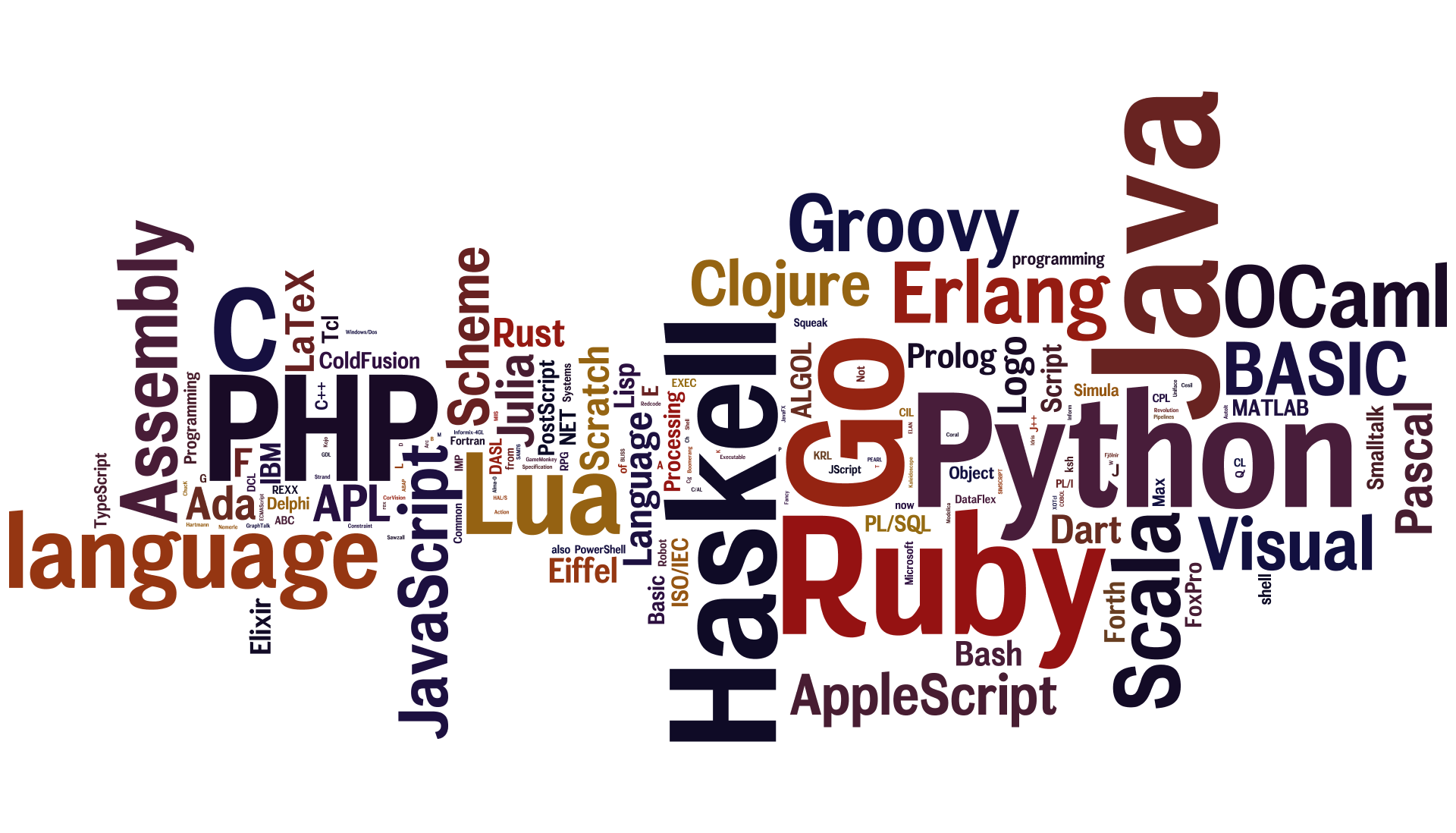
Scripting languages are a type of computer language that can be used to communicate with other software, such as a web browser, server, or standalone application. Scripting languages, such as JavaScript, PHP, Ruby, Python, and others, are among today’s most popular coding languages.
It’s no surprise that scripting languages are extensively used in web development because they make coding easier and faster.
However, that isn’t the only area in which they can be used. Operating systems, statistical analysis tools, office programs, game engines, and a variety of other platforms all have scripting languages.
Table of Contents
What Are Scripting Languages?
Scripting languages can automate job execution, enhance the functionality of the parent software, conduct setups, and extract data from data sets, among other things, inside a specific runtime environment.
There are two techniques to create scripting languages:
A runtime environment, such as Bash for the GNU operating system or VBA for Microsoft Office applications, can introduce its own scripting language.
A runtime environment can be built on top of an existing programming language; for example, MongoDB’s mongo shell is built on JavaScript.
On the other hand, as strange as it may sound, the scripting language may come first, giving birth to its own parent platform.
This is exactly what happened with Node.js, a backend runtime environment that allows web developers to use JavaScript not only on the frontend but also on the backend, conforming to the “JavaScript everywhere” idea.
What Does Scripting Mean in Programming?
Scripting is the process of writing a set of commands that an application or scripting engine interprets one by one. Even though the script instructs the platform on what to do (by providing a script to read and understand), the runtime environment, not the scripting language, is in charge of execution.
This is how scripting languages vary from programming languages like Java, which are designed to be written once and run anywhere (official Java slogan meaning Java programs can run as standalone applications in any environment; since being coined it has also become the WORA principle that refers to cross-platform capabilities).
Scripting Languages vs Programming Languages
Even though the terms “scripting language” and “programming language” are often used interchangeably, they are not synonymous.
Platform-Specific vs Platform-Agnostic
Programming languages are platform-agnostic (cross-platform) because they can execute themselves, whereas scripting languages are platform-specific. For example, a Java programme can run on any operating system.
(Mostly) Interpreted vs Compiled
While programming languages are compiled, scripting languages are primarily interpreted — however, some scripting languages, such as Python and Groovy, are both compiled and interpreted.
A compiled programming language has its own compiler, which transforms the syntax into machine code before it is executed. Scripting languages, on the other hand, are interpreted line by line by the platform’s interpreter during runtime.
Faster vs Slower at Runtime
Programming languages are faster than scripting languages because they do not need to be compiled in real time. Interpreters evaluate code line by line, pausing (or completely stopping) if a mistake occurs, whereas compilers perform collective error management before execution.
This lengthens the entire execution time of scripting languages, however, it is less of a problem on today’s faster hardware than it was earlier.
More vs Less Code-Intensive
Programming languages require more code since they require you to perform numerous tasks manually that are performed by the platform in scripting languages. You’ll have to write a lot less code if you utilise a scripting language.
Standalone Apps vs Apps as Part of a Stack
There are some things that a scripting language simply cannot perform. Most crucially, because there is no runtime environment that interprets scripting languages, they cannot be used to construct independent desktop and mobile programs.
Because PHP frameworks like WordPress and Laravel use the web browser as their runtime environment, you can only use them for websites and web apps. WordPress mobile apps, like Capacitor, run in mobile runtime environments that feature web views.
Scripting vs Programming Languages — Differences Overview
The following are the main distinctions between scripting and programming languages:
| Scripting languages | Programming languages |
| Platform-specific | Platform-agnostic (cross-platform) |
| (Mostly) interpreted | Compiled |
| Faster at runtime | Slower at runtime |
| More code-intensive | Less code-intensive |
| Creates standalone apps | Creates apps as part of a stack |
Confusions About Scripting Languages
There are a few common misunderstandings about scripting languages, so let’s go over them before moving on to the finest scripting languages.
Most significantly, even though many sites on the internet utilize this classification, it doesn’t make much sense to talk about frontend vs. backend scripting languages.
There is just one front-end scripting language in use right now, and that is JavaScript.
In the domain of scripting languages, the runtime environment(s) in which a scripting language can execute is more essential than the frontend vs. backend debate.
Note that ‘frontend’ simply refers to something that a web browser can comprehend (an image, typeface, markup, stylesheet, script, or another form of static file). Try opening a PHP file directly from a web browser: you can’t because it needs to be interpreted by a PHP application server — hence PHP is a backend scripting language in the context of web development, but the application layer of a server stack (e.g. LAMP) in the context of scripting languages.
Scripting languages can be used for a variety of tasks in addition to web development (frontend and backend scripting), including programming and customizing operating systems and specialized applications/environments, manipulating data sets, automating operations, and more.
A scripting language can also run in a variety of settings.
Read More:- What Is The Worst Zodiac Sign?
What Are Not Scripting Languages
Before we go into the top scripting languages, let’s have a look at several coding languages that are mistakenly referred to as scripting languages but can’t be used to write scripts:
- Markup languages include HTML and XML, for example. These are still JavaScript callbacks, even though HTML contains event handling attributes like onclick and on mouseover.
- CSS, Sass, and LESS are examples of stylesheet languages.
- Any scripting language-based library or framework, such as jQuery, PostCSS, React, Vue, Angular, Rails, Grails, Laravel, WordPress, Django, and others.
- Scripting language compilation languages like TypeScript and CoffeeScript.
- To manage data, SQL is utilized in relational database management systems (RDBMS) such as MySQL and MariaDB. You are not permitted to write dynamic code. Many RDBMSs, on the other hand, feature shells that allow you to use a scripting language (e.g. JavaScript or Python in the MySQL Shell).
- Runtime environments, such as NodeJS, for one or more scripting languages.
13 Best Scripting Languages
Many outstanding scripting languages deserve to be included in this list, but they are no longer being developed. The following 13 scripting languages, on the other hand, are regularly updated and are also used in production.
If you’re considering learning a new programming language as a new career route, they’re all worth looking at.
- JavaScript/ECMAScript
- PHP
- Python
- Ruby
- Groovy
- Perl
- Lua
- Bash
- PowerShell
- R
- VBA
- Emacs Lisp
- GML
1. JavaScript/ECMAScript

JavaScript implements the ECMA-262 standard, which defines the ECMAScript (ES) general-purpose scripting language. To put it another way, JavaScript is a dialect of the ECMAScript programming language. As a result, it lacks its own standard but follows the same grammar as ECMAScript.
JavaScript allows prototype-based object-oriented programming and has first-class functions (functions are treated as variables) (existing objects are reused as prototypes).
Code Example
Curly bracket syntax is used in ECMAScript. The following JavaScript code sample adds numbers from 1 to 10 and prints the result to the console (you can test it in the JavaScript console of your web browser by pressing F12):
let total = 0, count = 1;
while (count <= 10) {
total += count;
count += 1;
}
console.log(total);
// 55
Source: Eloquent JavaScript by Marijn Haverbeke: Introduction
Use Cases and Environments
Modern web browsers, such as Chrome’s V8 engine and Mozilla’s SpiderMonkey engine, employ JavaScript as their scripting language. It can be used in both non-browser and frontend web development environments. The NodeJS runtime environment was created to allow web developers to use NodeJS on the backend.
It is also used as a scripting language by the shells of various NoSQL database management systems, such as MongoDB and Apache CouchDB, and some relational database management systems, such as the aforementioned MySQL Shell.
2. PHP
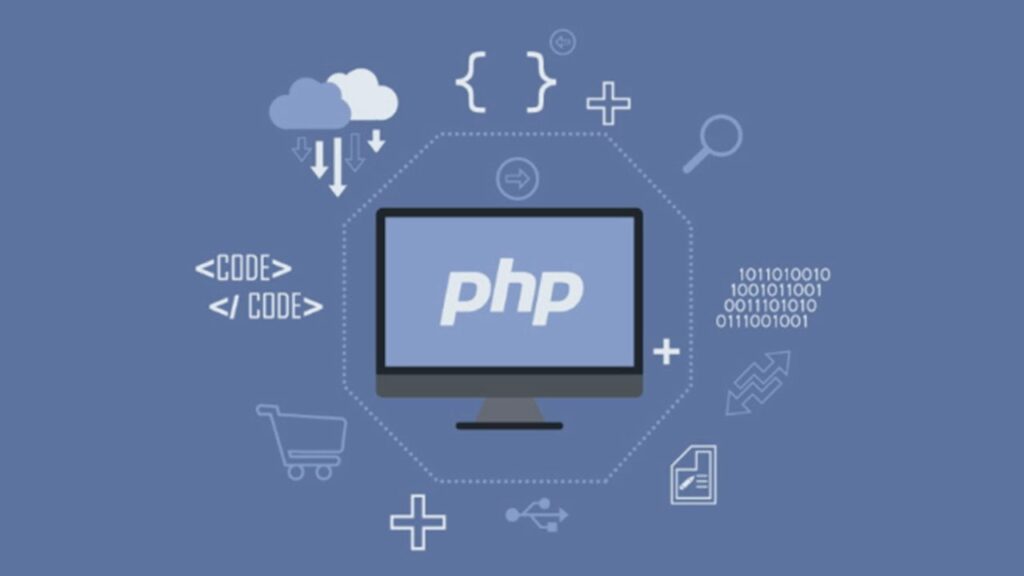
PHP is a widely used open-source programming language for backend web development. PHP was intended to bring dynamic functionality to static HTML pages, hence the acronym initially stood for ‘Personal Home Page.’
Since then, PHP has evolved into a stand-alone programming language, and the abbreviation is now used to refer to a “Hypertext Preprocessor.” PHP is object-oriented and weakly typed (you don’t have to define the data types of variables). It may also be incorporated in HTML texts.
Code Example
The syntax of PHP is similar to that of C. The following PHP code produces a four-element numeric array, loops through it, multiplies each item by two, and then unsets the $value variable at the end of the loop.
<?php
$arr = array(1, 2, 3, 4);
foreach ($arr as &$value) {
$value = $value * 2;
}
// $arr is now array(2, 4, 6, 8)
unset($value);
?>
Source: PHP documentation: Control Structures
Use Cases and Environments
PHP may run on a variety of HTTP servers, the most prominent of which being Apache and Nginx.
LAMP (Linux, Apache, MySQL, PHP), LEMP (Linux, Nginx, MySQL, PHP — used by Kinsta), WAMP (Windows, Apache, MySQL, PHP), and MAMP (Windows, Apache, MySQL, PHP) are the most frequent PHP server stacks (macOS, Apache, MySQL, PHP).
It’s also utilized by many major content management systems (CMS) like WordPress, Drupal, and Joomla, as well as web application frameworks like Laravel, Symfony, and CodeIgniter, which are all built on top of PHP and add new features to it.
PHP can also be used for local WordPress development. Check out our in-depth look at the key distinctions between Javascript and PHP.
3. Python
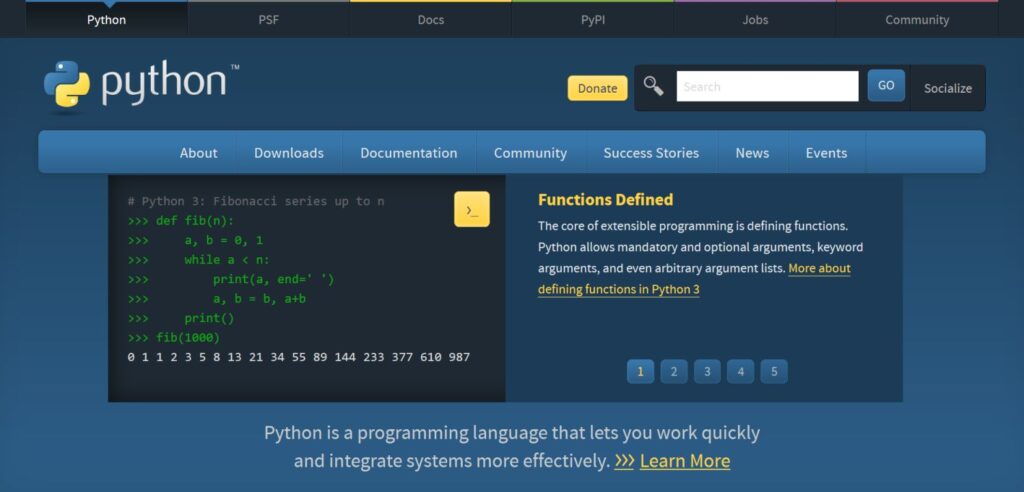
Python is currently the second most popular coding language on GitHub (after JavaScript). Python is well-liked for its clean and succinct syntax; coding in Python requires far less typing than coding in other languages.
Python is a free and open-source project that is managed by the Python Software Foundation. It has a huge Standard Library that contains commonly used Python modules and supports the structured, object-oriented, and functional programming paradigms.
Code Example
Python does not utilise curly brackets, and semicolons are optional, making the code easy to understand and write. The Python code below loops through integers ranging from 0 to 4 and writes them out:
count = 0 while count < 5: print(count) count += 1
Source: Learn Python: Loops
Use Cases and Environments
The most widely used Python implementation is CPython, which is built in the C programming language. It’s also the Python language’s reference implementation, which you get when you download the Python language. CPython uses both a compilation and an interpretation process, despite the fact that Python is an interpreted language. It begins by converting the original code to bytecode (rather than machine code), which it then evaluates at runtime.
Apart from CPython, Python offers a number of different runtime environments, the most notable of which is PyPy, which skips the compilation stage in favor of JIT (just-in-time) interpretation. Python implementations are cross-platform, which means they work on a variety of operating systems such as Linux, Windows, and macOS.
Machine learning, backend web development (the most popular web framework is Django), data analytics, automation, scientific computing, and web scraping are all common uses of Python.
4. Ruby
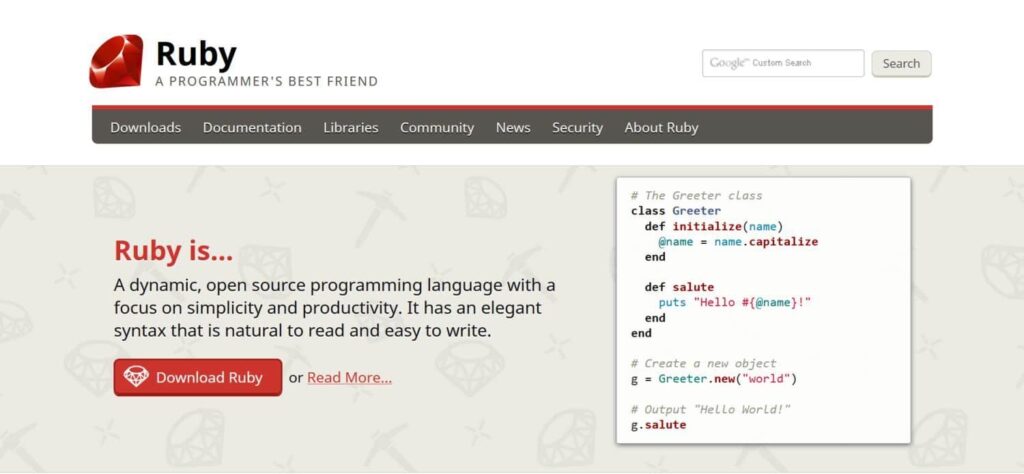
Ruby is a basic and easy-to-understand general-purpose scripting language that is free and open-source. It is one of the easiest programming languages to learn since it adheres to object-oriented programming principles and allows you to build clean and logical code. Even kinds that are primitives in most languages, such as booleans and integers, are objects in Ruby.
Inheritance, mixins, and metaclasses are all frequently utilised object-oriented notions.
While Ruby has a design that is strictly dedicated to objects, it enables procedure (functions and variables declared outside the classes form part of the Self-object) and functional programming (through anonymous functions, closures, and continuations).
Code Example
Ruby has a concise syntax similar to Python. The class KaraokeSong is defined as a subclass of Song in the Ruby example below:
class KaraokeSong < Song def initialize(name, artist, duration, lyrics) super(name, artist, duration) @lyrics = lyrics end end
Source: Programming Ruby reference guide: Classes, Objects, and Variables
Use Cases and Environments
Ruby is mostly utilized in backend web development, and it is the engine of some of the most robust online application frameworks, like Ruby on Rails. Many prominent websites and applications, such as Airbnb, Shopify, GitHub, and Hulu, use Ruby on Rails.
Many famous web development tools, like the Sass CSS preprocessor, the Jekyll static website generator, and the Vagrant virtual machine environment, are developed in Ruby.
Ruby’s default implementation is YARV (Yet Another Ruby Virtual Machine). It took the place of Matz’s Ruby Interpreter (also known as Ruby MRI or CRuby), which was criticized for its slowness and scalability.
JRuby (which lets you run Ruby on the Java Virtual Machine), mruby (a lightweight implementation that you can embed within your application), TruffleRuby (Oracle’s Ruby interpreter built on GraalVM), Rubinius (a cloud-native virtual machine for Ruby), and others are all competing runtime environments for Ruby.
5. Groovy

Groovy is a highly versatile language for the Java Virtual Machine (JVM) that may be used for both scripting and programming. The Apache Software Foundation manages it as an open-source project. Groovy is a Java. lang-based object-oriented programming language. Superclass for objects.
It features native support for lists, associative arrays, regular expressions, and markup languages like HTML and XML, and supports both static and dynamic typing (type checking can be done both at build time and runtime).
Groovy can be used in conjunction with current Java libraries.
Code Example
Groovy uses curly brackets and has a Java-like syntax. The Coordinates class is defined in the following Groovy code sample, along with the latitude and longitude properties and the getAt() method:
@Immutable
class Coordinates {
double latitude
double longitude
double getAt(int idx) {
if (idx == 0) latitude
else if (idx == 1) longitude
else throw new Exception("Wrong coordinate index, use 0 or 1")
}
}
Source: Groovy Documentation: Semantics
Use Cases and Environments
Groovy may be used as a general-purpose programming language similar to Java because it compiles Java byte code. In this instance, you can use the Groovy compiler to compile the source code into byte code before running it (the equivalent to Javac).
Many Groovy implementations, on the other hand, allow you to utilize it as a scripting language. The Grails online application framework (previously known as Groovy on Grails) and the Gradle build automation tool is the most popular, but there are others as well.
6. Perl
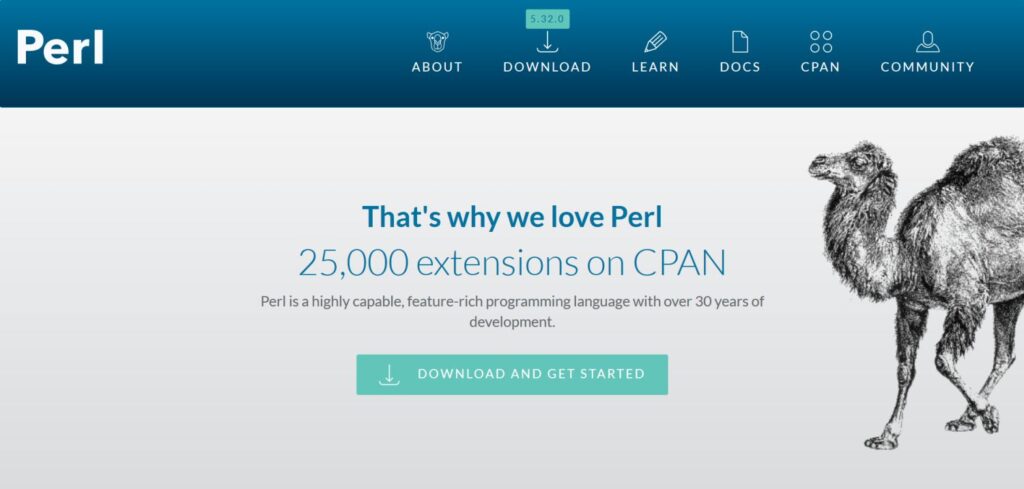
Perl is a versatile scripting language with a nearly thirty-year history (since 1987). It began as a UNIX scripting language for report processing. The Perl abbreviation stands for ‘Practical Extraction and Reporting Language,’ and its name is derived from that.
The Perl programming language rose to prominence in the 1990s when programmers began to use it for CGI (Common Gateway Interface) scripting, an older web server interface specification (now only used by legacy sites).
Perl is the 11th most popular language on GitHub and the 11th most popular on the TIOBE index, despite being a latecomer (as of Feb 2024).
Code Example
The syntax of Perl is comparable to that of C. The following Perl code example first constructs the square() subroutine, which calculates and returns the square of an integer, before passing the value 8 as an input, running the function, and saving the result into the $sq variable:
sub square {
my $num = shift;
my $result = $num * $num;
return $result;
}
$sq = square(8);
Source: Perl docs: Perl Intro
Use Cases and Environments
Perl can be successfully utilized in backend development, despite the fact that it isn’t the most popular choice among web developers these days. It runs on the Apache and Nginx web servers in addition to the CGI runtime environment – the LAMP stack is actually LAMPP, which stands for Linux, Apache, MySQL, PHP, and Perl.
There are a number of Perl web development frameworks, with Catalyst, Mojolicious, and Dancer being the most prominent.
Amazon, IMDB, Booking.com, and the BBC iPlayer are just a few of the well-known websites and applications that employ Perl. It’s also utilized in domains like system administration and network programming. You can also look via the Comprehensive Perl Archive Network (CPAN), which includes over 25,000 open-source Perl projects.
7. Lua

Lua is a fast and lightweight scripting language. The term “Lua” means “moon” in the language developed and maintained by the Pontifical Catholic University of Rio de Janeiro in Brazil. Lua supports the procedural, object-oriented, and functional programming paradigms.
Lua’s interpreter is written in C, thus it’s easy to incorporate into programs thanks to its C API. Lua can be used to supplement existing C-based programming languages such as C, C++, C#, Java, Perl, Ruby, and others.
Code Example
Lua, like Python and Ruby, has a compact and easy-to-read syntax. The if-then-else statement is demonstrated in the Lua code below. It first evaluates the op variable, and then uses its value to do fundamental arithmetic operations:
if op == "+" then
r = a + b
elseif op == "-" then
r = a - b
elseif op == "*" then
r = a * b
elseif op == "/" then
r = a / b
else
error("invalid operation")
end
Source: Programming in Lua reference guide: Statements
Use Cases and Environments
The default Lua implementation does not directly parse source code; instead, it compiles it to byte code, which is then executed on the Lua virtual machine. There is no need to do a manual compilation step because everything happens at runtime (even though you can opt for compiling Lua before runtime to improve performance).
Other Lua implementations include LuaJIT, LuaVela, and a number of others.
Angry Birds, World of Warcraft, and Grim Fandango are all examples of video games that employ Lua. It’s a popular choice for embedded devices like set-top boxes, car instrument panels (e.g. Volvo), IP cameras (e.g. Cisco), and others because it’s straightforward to embed.
Because both Apache and Nginx servers have a Lua module (here’s Apache’s mod lua and here’s Nginx’s ngx http lua module), it can be used in web development. Lua was chosen as the template scripting language by Wikipedia, and the UI of Adobe Photoshop Lightroom is also written in Lua.
8. Bash
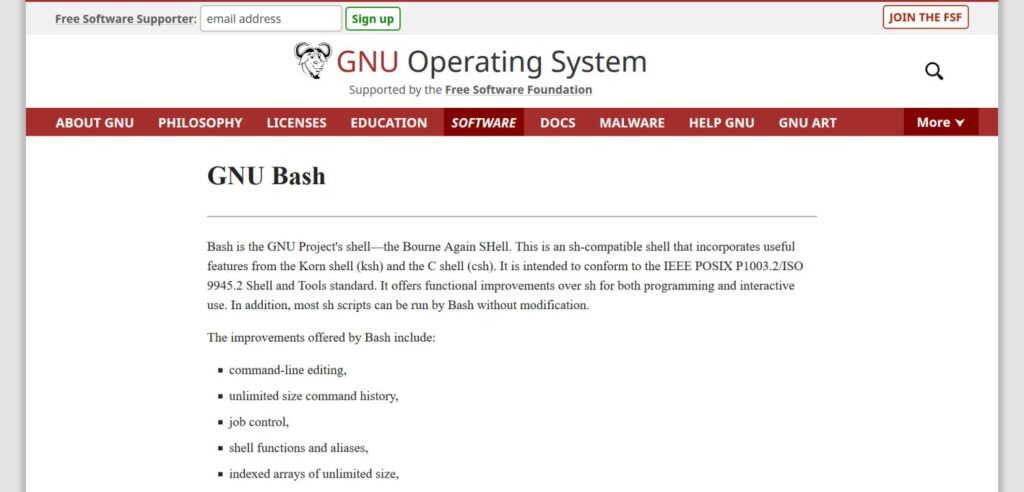
Bash is the name of both a command-line interpreter (shell) and a scripting language for the GNU operating system. The GNU operating system uses the Linux kernel (a kernel is the fundamental portion of the operating system; it is the first software loaded by the operating system).
The Bash abbreviation stands for ‘Bourne-Again SHell’ (a pun on ‘born again shell’) and is a successor for the original UNIX Bourne shell (sh).
Bash combines capabilities from other shell scripting languages such as KornShell (ksh) and C shell (csh), such as command-line editing and command history, in addition to being a superset of the Bourne shell syntax. Bash can be used in interactive mode (where you type one command at a time and wait for the system to respond) or scripting mode (where you run a series of commands — a Bash script — all at once).
Code Example
Bash, like most CLI scripting languages, has a straightforward syntax. The following Bash code example picks a file from the current folder and displays its name and index in a message:
select fname in *;
do
echo you picked $fname \($REPLY\)
break;
done
Use Cases and Environments
You can use Bash to make changes to your operating system and perform various tasks, such as executing commands, performing tasks that most people would do with a graphical user interface (e.g. creating, moving, or deleting folders and files), customizing and automating administrative tasks, connecting to a remote server, and so on.
Bash is the default shell for many Unix-based operating systems, including most Linux distributions and all MacOS releases until 2019, when Z shell (Zsh) superseded Bash. You can also run Bash scripts on Windows 10 thanks to Microsoft’s Windows Subsystem for Linux (WSL) compatibility layer.
9. PowerShell

PowerShell was originally designed to be a command-line shell and scripting language for the Windows operating system. Since then, Microsoft has open-sourced it and moved it from the .NET Framework, which can only generate Windows programs, to .NET Core, which can create apps for Windows, Linux, and macOS. As a result, PowerShell is now available on all platforms.
It’s also been renamed PowerShell Core, which corresponds to the underlying foundation. PowerShell, unlike most command-line shells, takes and returnss.NET objects rather than plain text, which opens up new possibilities for job automation.
Code Example
PowerShell offers a concise syntax that makes command-line operations go faster. The following PowerShell code makes a backup of the boot.ini file and stores it to the boot .bak file:
Copy-Item -Path C:\boot.ini -Destination C:\boot.bak
Source: PowerShell Documentation: Working with Files and Folders
Use Cases and Environments
PowerShell is available for use on Windows, Linux, macOS, and some ARM devices (e.g. wearables, multimedia players, tablets, and other consumer electronic devices).
System administration, task automation, and configuration management are all possible using PowerShell. You can also look for PowerShell modules and scripts in the PowerShell Gallery and Microsoft’s official sample script collection.
10. R
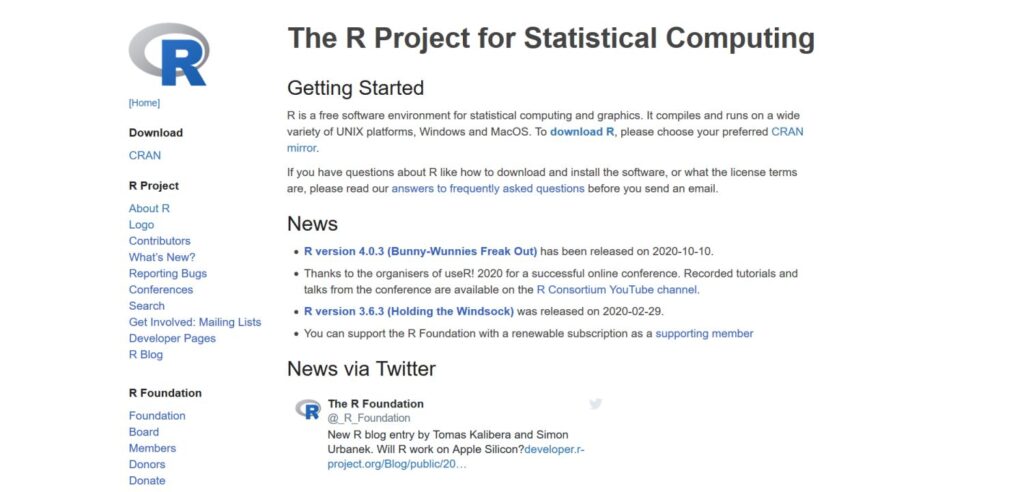
R is a statistical computation, data analysis, and graphical presentation software environment as well as a programming language. It’s a GNU project that’s free and open-source, and it implements the S statistical computing language (not in active development anymore).
Many diverse statistical techniques are available in R, including conventional statistical tests, clustering, time series analysis, linear and non-linear modelling, and more.
Code Example
The fundamental assignment operator in R is – instead of the = equals sign, and it contains loopless loops — see more about the oddities of the R syntax in Sharon Machlis’ beginner’s guide to R for additional information.
The following R code example creates a names property for the fruit vector, which uses alphanumeric names (orange, banana, apple, peach) to help identify its components. Later, the lunch (or another) subvector might use the alias name to retrieve each component:
> fruit <- c(5, 10, 1, 20)
> names(fruit) <- c("orange", "banana", "apple", "peach")
> lunch <- fruit[c("apple","orange")]
Source: An Introduction to R: Index vectors; selecting and modifying subsets of a data set
Use Cases and Environments
The R software environment is cross-platform, meaning it works on Windows, Linux, and Mac OS X. Some other scripting languages, such as Python and Perl, support the default R implementation. This means that you can use these programming languages to access all of R’s statistical capability.
You can utilize the R scripting language in different settings besides the typical R environment, such as pqR (which stands for ‘a reasonably speedy version of R’) and Renjin (an R implementation on top of the Java Virtual Machine).
11. VBA

VBA stands for Visual Basic for Applications, and it’s a Visual Basic 6 programming language implementation (not in active development since 2008). It was designed for Microsoft Office applications to allow developers to automate tedious activities, add new features, and communicate with document end users.
VBA, like Visual Basic, adheres to the event-driven programming paradigm, which places events such as user actions at the core of the program’s flow.
Because Microsoft Office applications have a graphical user interface, VBA scripts can be attached to menu buttons, keyboard shortcuts, macros (programmable patterns), and OLE events (Object Linking and Embedding, a proprietary Microsoft technology that allows you to control one application from another).
Code Example
VBA has a syntax comparable to the BASIC (Beginners’ All-purpose Symbolic Instruction Code) family of languages because it is based on Visual Basic (which is an augmentation of BASIC). This makes it very beginner-friendly.
The GetCertificateDetail() function of the SignatureInfo object is used in the VBA code below to acquire the expiration date of a digital certificate:
Sub GetCertDetails() Dim objSignatureInfo As SignatureInfo Dim varDetail As Variant strDetail = objSignatureInfo.GetCertificateDetail(certdetExpirationDate) End Sub
Source: Office VBA Reference: SignatureInfo object
Use Cases and Environments
Most Microsoft Office applications include the VBA scripting language, which is embedded in Access, Excel, Office for Mac, Outlook, PowerPoint, Project, Publisher, Visio, and Word. Each application has its own reference guide on Microsoft’s documentation site, while general VBA concepts are covered in the library reference.
Other software, such as AutoCAD and CorelDRAW, offer VBA in addition to Microsoft Office applications.
12. Emacs Lisp

For the GNU Emacs text editor, the Emacs Lisp scripting language was created. It’s a dialect of the Lisp programming language family (the name comes from the LISt Processor).
Because Emacs Lisp was created to be used in a code editor, it has features like text scanning and parsing, buffer (objects with editable text), and display management, among others.
Because the Emacs Lisp scripting language is tightly linked with the editor interface, each command is actually a Lisp function that may be called from your script, and customization options are also Lisp variables.
Code Example
If you’ve never dealt with a Lisp language before, the syntax of Emacs Lisp is built on a fully parenthesized prefix notation, which can be difficult to comprehend at first.
The following Emacs Lisp code example creates two variables (symbols) and assigns a set of values to each of them: a list of trees (pine, fir, oak, maple) for the symbol trees, and a list of herbivores (gazelle, antelope, zebra) for the symbol herbivores:
(setq trees '(pine fir oak maple) herbivores '(gazelle antelope zebra))
Source: An Introduction to Programming in Emacs Lisp: Setting the Value of a Variable
Use Cases and Environments
The Emacs text editor is a cross-platform program that works on Windows, Linux, and Mac computers.
You may use the Emacs Lisp scripting language to extend and personalize the code editor, make graphs, restrict focus to certain areas (for security), search regular expressions, save text, set modes and keymaps, and ask users questions, among other things.
Doom Emacs and Spacemacs are two of the most well-known Emacs Lisp configuration frameworks.
13. GML
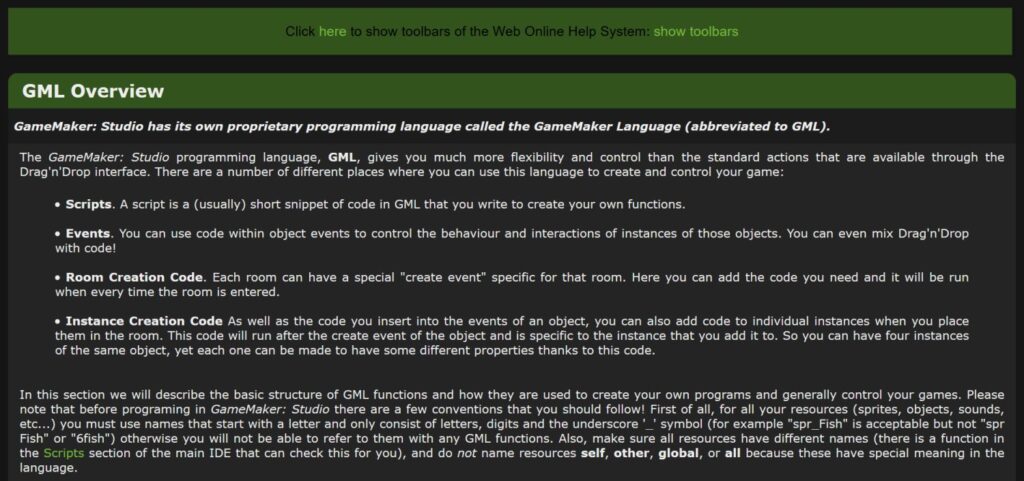
GameMaker Language is abbreviated as GML. It’s a wonderful example of a domain-specific scripting language for game creation. GameMaker Studio 2, a cross-platform game engine and development platform owned and run by YoYo Games, uses GML as a proprietary scripting language.
Despite the fact that GML is primarily used for manipulating game objects, it is a procedural language rather than an object-oriented one. It allows you to use any game object to call custom scripts.
GameMaker Studio 2 has a visual programming tool called Drag and Drop in addition to the GML scripting language (DnD). You may also mix DnD with your GML scripts thanks to GameMaker Studio 2’s flexibility.
Code Example
GML has a syntax that’s similar to JavaScript and other C-like languages.
A gaming item advances horizontally towards the mouse pointer on the screen at a speed of 5 pixels per step in the GML code below. The script generates an explosion effect layer, runs it (an explosion effect appears on the screen), and then destroys the instance once it reaches the current position of the pointer (the explosion effect gets removed):
if mp_linear_step(mouse_x, mouse_y, 5, 0) {
instance_create_layer(x, y, "Effects", obj_Explosion);
instance_destroy();
}
Source: GameMaker Studio 2 Docs – Scripting – GML Reference – Movement and Collisions – Motion Planning
Use Cases and Environments
GML is interpreted by GameMaker Studio 2, which you’ll need to get if you wish to use this scripting language to make games.
Pricing varies by platform, with Mac and Windows games being the least expensive; cross-platform (Windows, macOS, Ubuntu) desktop games, HTML5 web games, UWP (Universal Windows Platform) games, and cross-platform (Android, Fire, iOS) mobile games being in the middle; and PS4, Xbox One, and Nintendo Switch games being at the top.
Blackhole, 10 Second Ninja X, Death’s Gambit, Deltarune, and other video games made with GML are only a few examples.
Summary
Scripting languages are, without a question, intriguing. They can be used for a variety of reasons and come in a variety of forms, syntaxes, and implementations.
From developing dynamic websites to automating system administration to creating video games, and so forth.
The following are the three most crucial factors to keep in mind when using scripting languages:
They can’t run on their own; they require an environment (implementation, runtime) that includes a scripting language interpreter.
Environments and platforms created for different programming or scripting languages can occasionally be accessed using general-purpose scripting languages. Consider JRuby (which allows you to run Ruby on the Java Virtual Machine), Renjin (another R implementation on the JVM), and Rpy2 (an R interface that you can use from Python).
Finally, before you start learning a new programming language, check out the TIOBE index or GitHub to discover how popular it is right now.
You’ll also find more or fewer sample scripts, GitHub repositories, module libraries, reference guides, extensive manuals, and app showcases, depending on the language. These resources will help you get started with the language… and land better-paying projects and employment!




